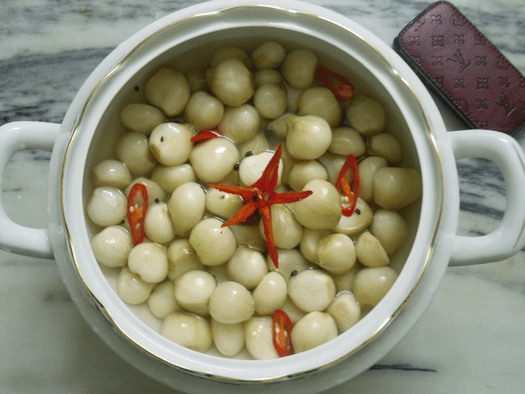 |
| Crunch: Salted, pickled onions are one of the most tasty foods at Tết. Photo monngon.org |
Viet Nam News
by Hà Nguyễn
Rich or poor, Vietnamese at home or abroad carefully cook traditional dishes to put on the home altar to worship their ancestors during Tết (Lunar New Year) festival.
At Tết, each ethnic group has its own culinary specialties that reflect the culture of their people. Most Kinh (Vietnamese ethnic majority) people start preparations a month before the festival.
My mother usually cooked nine dishes: bánh chưng (square sticky rice cake), dưa hành (pickled onions), giò nạc (boiled lean pork sausage) and giò thủ (boiled pork head sausage), thịt đông (frozen meat), nem rán (spring rolls), canh măng ( bamboo shoot soup), canh bóng thả (dried pig skin soup), boiled chicken, and chè kho (sweet green bean paste).
Of all the dishes, bánh chưng is the soul of Tết, reflecting the quintessence of heaven and earth through the skilled hands of humans. My mother had to invest much time and effort to make the cakes. She had to choose the most fragrant and fibrous sticky rice to make a cake that can last for a month. They often had pork, green beans, dried onions and pepper in the centre.
I remember my mother wrapping the cake like a professional. In two hours, she would wrap 30 big square cakes (1.5kg each), which she asked us to line them up in a big pan for almost 14 hours. “Your mother’s bánh chưng are the most tasty and they are much bigger than others,” said one of my neighbours.
The cakes are often eaten with dưa hành (pickled onion) because its sour and light peppery flavour helps digestion. Meanwhile, giò nạc and giò thủ have remained on the offering food tray at Tết from the past to the present.
Culinary expert Nguyễn Ánh Tuyết said for Vietnamese, a plate of these foods had played an important role in turning traditional offerings into delicacies.
Thịt đông (frozen meat) of pork or chicken is a particular Tết dish for northerners.
Tuyết said the dish was easy to cook. Ingredients included bacon or chicken plus 0.2kg of pig skin. All are cut into small rectangles (two fingers) then stewed slowly for an hour and then let cool before putting in a fridge.
“In the past, few people had a fridge, so I often put a pot of
thịt đông on the ground outside for the night during the winter. The cold froze the food, which was served with pickled onions,” said Tuyết. "One never forgets its taste."
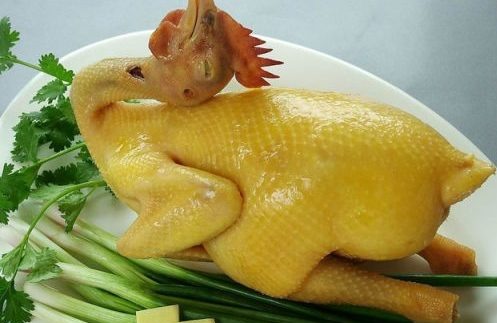 |
| A must: Most Vietnamese offer a whole boiled chicken to their ancestors. |
Nem (spring rolls) is a popular dish in the north that always has a place on a Tết food tray because it is so flavourful and healthy. It is made out of minced pork, carrots, wood ear fungus, green-bean sprouts, bean glass noodles and other ingredients. The fried rolls are then dipped into a bowl of sauce of mixed fish sauce, sugar, lemon or vinegar, chili and minced garlic.
The Tết food tray of northerners never lacks a big bowl of canh măng khô (dried bamboo shoot soup). Tuyết said the soup could be eaten throughout the Tết holiday. “Canh măng with rice vermicelli or noodles helps always is a winner,” she said.
Canh bóng thập cẩm (Assorted dried pig skin soup) is a Hà Nội delicacy made from kohlrabi, carrots, peas, shrimp, pork tenderloin, and lean pork paste. “It is a dainty dish. Hanoians often cut the carrots into flower shapes, scoop the pork paste into balls and slice the fried eggs into thin threads. They add it to the chicken broth with dried skin pig (similar to dried fish bladder),” said Tuyết.
The last two dishes on the tray are boiled chicken and chè kho (sweet green bean paste). People believe the boiled chicken offered to heaven in spring will bring advantages and happiness year round. Yellow-chicken meat covered with sliced lemon leaves is dipped in a bowl of salt, lemon, chili and pepper. “It is more enjoyable when eating a 1.3-1.4kg free range chicken raised by small farmers,” said Tuyết.
Chè kho is another popular dish with Hanoians. The dish is made of green beans, white sesame and sugar. Elderly people say the dish brings children good luck at studies and good health for themselves. “The dish exudes the special fragrance of green beans and has the buttery taste of white sesame. It melts in your mouth,” Tuyết said.
 |
| Creamy: Chè kho or soft green lentil cake is a Tết desert believed to bring good luck. |
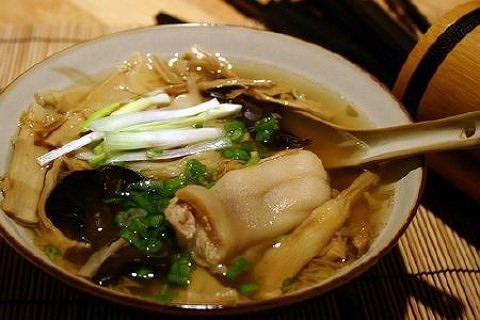 |
| Healthy: Bamboo soup helps people to feel better at Tết. |
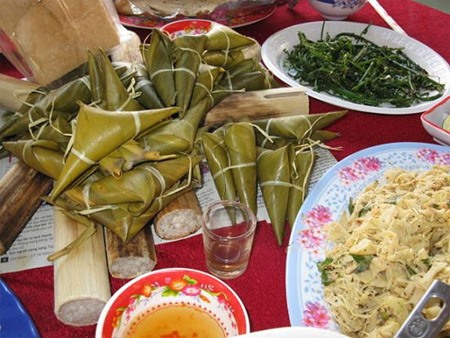 |
| Tribal: Buffalo-horn cake from the Cơ Tu ethnic group in the Central Highland region. |
Ethnic groups, such as the Mông, Thái, Mường, Tày, Nùng, Dao, and Cơ Tu have their own NewYear dishes. Culinary expert Lê Kim Chi said for the Mông, their Tết tray should include dishes such as pork, wine, round cakes made from glutinous rice and maize cakes.
Fried fish is the specific dish of the Thái. They believe the stream deity will protect them from danger.
Chi said the Nùng group often made bánh khảo from dried glutinous rice powder, minced pork fat and sugar to worship their ancestors. The elderly said the sweet fat in the cake would prevent unlucky happenings in the New Year.
Meanwhile, the Cơ Tu in Tây Nguyên (the Central Highlands) make their own wine known as rượu Tà Vạt and rượu cần to welcome Tết. All visitors at New Year are invited to enjoy these wines.
Each Dao household has its own thịt lợn chua (sour pork), locally known as ò sui, in New Year holidays. Ingredients include pork, salt, and cool rice. The dish should be eaten with lá lốt (wild lolot leaves) and lá prang lẩu (wild leaves), and dipped in a bowl of mixed lemon and chili.
The Tày welcome Lunar New Year with a roast piglet. They often choose local piglets with small bones, firm and lean meat weighing from 20kg to 30kg. People often put mắc mật (a kind of wild leaf and fruit) mixed with spices in the pig’s belly and cover the skin with honey. They then roast it on charcoal for three hours until well done. The food is dipped in a sweet and fragrant sauce gotten from the pig’s belly.
One Tày elder, Nông Văn Coỏng, said in the past rich people often offered an entire roast piglet on their altar, while the poor used only the head.
Coỏng said this tradition had existed for hundreds of years because his people believed the pig offering brings them a bumper harvest and good life in the New Year. VNS
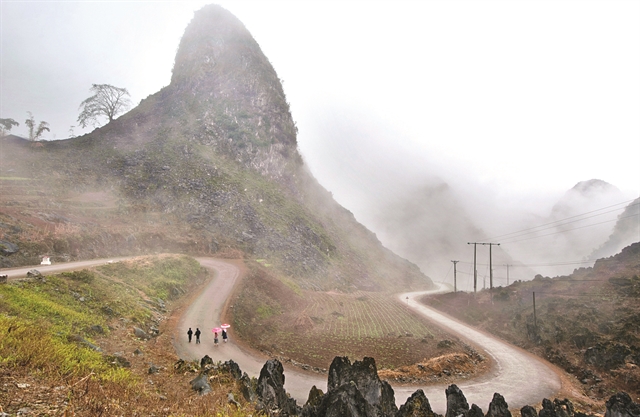 Sunday/Weekend
Sunday/Weekend










